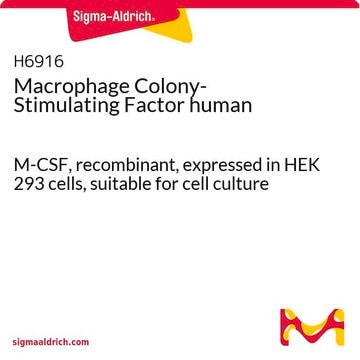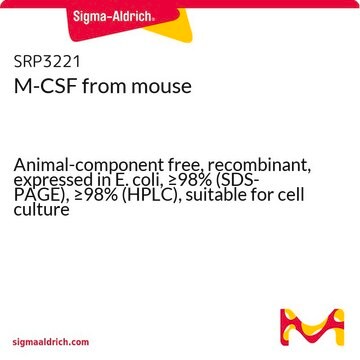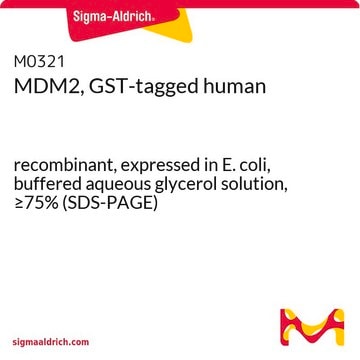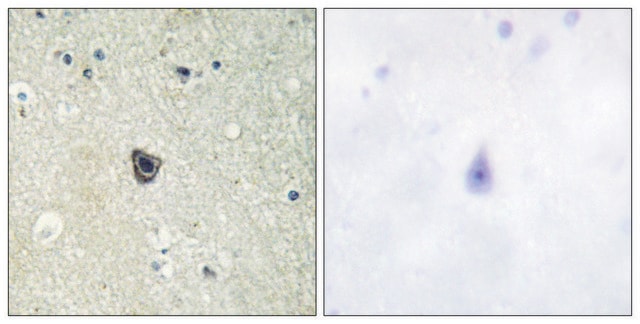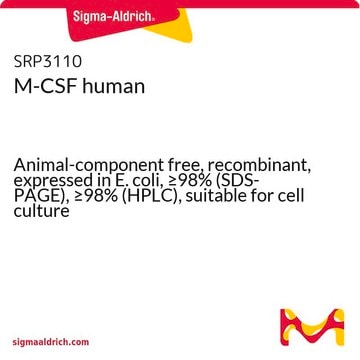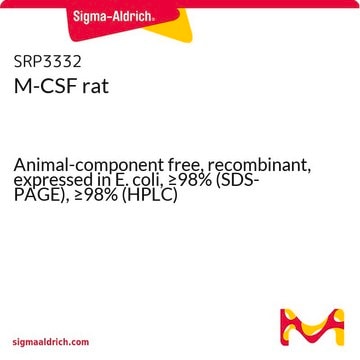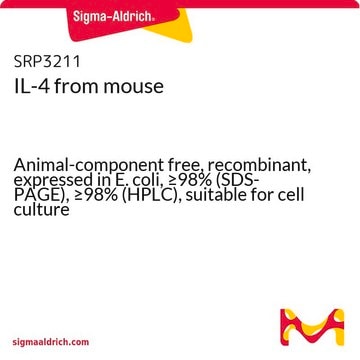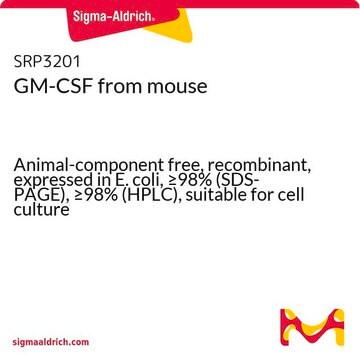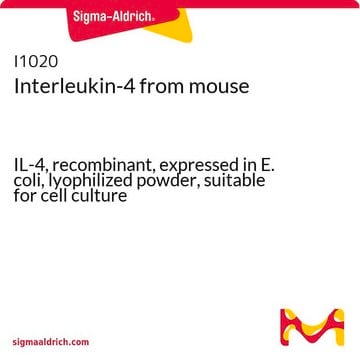M9170
Macrophage Colony-Stimulating Factor from mouse
recombinant, expressed in E. coli, lyophilized powder, suitable for cell culture
Synonym(s):
mCSF-1, mM-CSF, CSF-1, M-CSF
Sign Into View Organizational & Contract Pricing
All Photos(2)
About This Item
CAS Number:
EC Number:
MDL number:
UNSPSC Code:
12352202
eCl@ss:
32190102
NACRES:
NA.77
Recommended Products
Looking for similar products? Visit Product Comparison Guide
Application
Macrophage Colony-Stimulating Factor from mouse has been used:
- in the initiation of osteoclastogenesis in bone marrow monocyte cells
- to stimulate osteoclast differentiation in non-adherent hematopoietic cell
- for the generation of blood-derived stem cells
Biochem/physiol Actions
Macrophage Colony Stimulating Factor (M-CSF), also known as CSF-1, can be produced by a number of cells, including fibroblasts, monocytes, activated macrophages, secretory epithelial cells of the endometrium, endothelial cells activated by LPS or cytokines, and bone marrow stromal cells. In addition to its namesake activity, M-CSF can stimulate the proliferation of isolated macrophages, augment the production and release of cytokines and other inflammatory modulators from macrophages, enhance macrophage antibody-dependent cell-mediated cytotoxicity, prime and enhance macrophages in their ability to kill tumor cells and other microorganisms, stimulate pinocytosis, and support osteoclast differentiation. M-CSF binds and activates a 165 kDa glycoprotein of the receptor tyrosine kinase subclass III or the RTK subfamily. Due to alternative splicing of a single M-CSF gene and due to variations in glycosylation, the molecular weight of natural soluble M-CSF ranges from 44-86 kDa. Human and mouse M-CSF share approximately 80% sequence homology in the conserved N-terminal region of 150 amino acids. Although human M-CSF is active in murine systems, mouse M-CSF appears to be species-specific in its actions.
Physical form
Lyophilized from a sterile filtered buffered aqueous solution.
Analysis Note
The proliferative activity is tested by the dose-dependent stimulation of the murine monocytic cell line, M-NFS-60.
Signal Word
Warning
Hazard Statements
Precautionary Statements
Hazard Classifications
Eye Irrit. 2 - Skin Irrit. 2 - STOT SE 3
Storage Class Code
11 - Combustible Solids
WGK
WGK 2
Flash Point(F)
Not applicable
Flash Point(C)
Not applicable
Personal Protective Equipment
dust mask type N95 (US), Eyeshields, Gloves
Certificates of Analysis (COA)
Search for Certificates of Analysis (COA) by entering the products Lot/Batch Number. Lot and Batch Numbers can be found on a product’s label following the words ‘Lot’ or ‘Batch’.
Already Own This Product?
Find documentation for the products that you have recently purchased in the Document Library.
Customers Also Viewed
Rapid Rapamycin-only induced osteogenic differentiation of blood-derived stem cells and their adhesion to natural and artificial scaffolds
Arianna C, et al.
Stem Cells International, 2017 (2017)
Strain differences in the attenuation of bone accrual in a young growing mouse model of insulin resistance
Rendina-Ruedy E, et al.
Journal of Bone and Mineral Metabolism, 34(4), 380-394 (2016)
Yan Li et al.
Journal of immunology (Baltimore, Md. : 1950), 191(6), 3192-3199 (2013-08-13)
Engraftment of human CD34⁺ hematopoietic stem/progenitor cells into immunodeficient mice leads to robust reconstitution of human T and B cells but not monocytes and macrophages. To identify the cause underlying the poor monocyte and macrophage reconstitution, we analyzed human myeloid
Verena Turco et al.
Nature communications, 14(1), 771-771 (2023-02-12)
Glioblastoma, the most common and aggressive primary brain tumor type, is considered an immunologically "cold" tumor with sparse infiltration by adaptive immune cells. Immunosuppressive tumor-associated myeloid cells are drivers of tumor progression. Therefore, targeting and reprogramming intratumoral myeloid cells is
B F Boyce
Journal of dental research, 92(10), 860-867 (2013-08-03)
Osteoclasts are derived from mononuclear hematopoietic myeloid lineage cells, which are formed in the bone marrow and are attracted to the bloodstream by factors, including sphingsine-1 phosphate. These circulating precursors are attracted to bone surfaces undergoing resorption by chemokines and
Our team of scientists has experience in all areas of research including Life Science, Material Science, Chemical Synthesis, Chromatography, Analytical and many others.
Contact Technical Service